Rethinking Vertical Cities: The Influence of Public Perception on Design, Form, and Socio-Cultural Integration
Abstract
1. Introduction
2. Literature Review
2.1. Conceptualizing Public Satisfaction
2.2. Global and Regional Perspectives on High-Rise Development
2.3. Regional Context: Gulf Urbanization and Muscat’s Pivot to Height
2.4. Determinants of Public Satisfaction in the Built Environment
3. Theoretical Model
3.1. Theoretical Foundation and Research Gaps
3.2. Conceptual Framework and Hypotheses
3.3. Why Smart PLS-SEM?
3.4. Analytical Procedure
4. Materials and Methods
4.1. Study Area
4.2. Data Collection
4.3. Sample Adequacy and Preliminary Data Diagnostics
4.4. Application of Partial Least Squares Structural Equation Modeling (PLS-SEM)
5. Results
5.1. Distribution of Socio-Economic Demographics (SEDs)
5.2. Measurement Model Evaluation
- Convergent Validity and Individual Item Reliability.
- Discriminant Validity.
- Heterotrait–Monotrait Ratio of Correlations.
- Structural Model Assessment.
- Overall Model Fit.
5.2.1. Convergent Validity and Individual Item Reliability
5.2.2. Discriminant Validity: Fornell–Larcker Criterion and Cross-Loadings
5.2.3. Heterotrait–Monotrait Ratio of Correlations
5.2.4. Structural Model Assessment
5.2.5. Overall Model Fitness Analysis
6. Discussion
Implications for Theory and Practice
7. Conclusions
8. Limitations and Future Research Directions
Supplementary Materials
Author Contributions
Funding
Institutional Review Board Statement
Informed Consent Statement
Data Availability Statement
Acknowledgments
Conflicts of Interest
References
- Aljabri, H. The Planning and Urban Design of Liveable Public Open Spaces in Oman: Case Study of Muscat. Ph.D. Thesis, Heriot-Watt University, Edinburgh, UK, 2014. [Google Scholar]
- Hegazy, S. Continuity and change of Muscat house–influencing factors and responses. Int. J. Adv. Res. 2015, 3, 95–107. [Google Scholar]
- Architects, Z.H. Al Khuwair Muscat Downtown and Waterfront Development. Available online: https://www.zaha-hadid.com/architecture/al-khuwair-muscat-downtown-and-waterfront-development/ (accessed on 26 June 2025).
- Venter, C.J. Measuring the quality of the first/last mile connection to public transport. Res. Transp. Econ. 2020, 83, 100949. [Google Scholar] [CrossRef]
- Hashemnezhad, H.; Heidari, A.A.; Mohammad Hoseini, P. “Sense of place” and “place attachment”. Int. J. Archit. Urban Dev. 2013, 3, 5–12. [Google Scholar]
- Danese, M.; Nolè, G.; Murgante, B. Visual impact assessment in urban planning. In Geocomputation and Urban Planning; Springer: Berlin/Heidelberg, Germany, 2009; pp. 133–146. [Google Scholar]
- Marans, R.W. Quality of urban life studies: An overview and implications for environment-behaviour research. Procedia-Soc. Behav. Sci. 2012, 35, 9–22. [Google Scholar] [CrossRef]
- Forrest, R.; Kearns, A. Social cohesion, social capital and the neighbourhood. Urban Stud. 2001, 38, 2125–2143. [Google Scholar] [CrossRef]
- Lee, P.; Burfitt, A.; Tice, A. The creative economy and social sustainability: Planning for opportunity and growth. Built Environ. 2009, 35, 267–280. [Google Scholar] [CrossRef]
- Sirgy, M.J.; Cornwell, T. How neighborhood features affect quality of life. Soc. Indic. Res. 2002, 59, 79–114. [Google Scholar] [CrossRef]
- Giridharan, R.; Ganesan, S.; Lau, S. Daytime urban heat island effect in high-rise and high-density residential developments in Hong Kong. Energy Build. 2004, 36, 525–534. [Google Scholar] [CrossRef]
- Lotfabadi, P. High-rise buildings and environmental factors. Renew. Sustain. Energy Rev. 2014, 38, 285–295. [Google Scholar] [CrossRef]
- Kalantari, S.; Shepley, M. Psychological and social impacts of high-rise buildings: A review of the post-occupancy evaluation literature. Hous. Stud. 2021, 36, 1147–1176. [Google Scholar] [CrossRef]
- Al-Kodmany, K. The sustainability of tall building developments: A conceptual framework. Buildings 2018, 8, 7. [Google Scholar] [CrossRef]
- Wener, R.; Carmalt, H. Environmental psychology and sustainability in high-rise structures. Technol. Soc. 2006, 28, 157–167. [Google Scholar] [CrossRef]
- Ahlfeldt, G.M.; Barr, J. The economics of skyscrapers: A synthesis. J. Urban Econ. 2022, 129, 103419. [Google Scholar] [CrossRef]
- Alkamali, N.; Alhadhrami, N.; Alalouch, C. Muscat City expansion and Accessibility to the historical core: Space syntax analysis. Energy Procedia 2017, 115, 480–486. [Google Scholar] [CrossRef]
- Zahiri, N.; Dezhdar, O.; Foroutan, M. Rethinking of critical regionalism in high-rise buildings. Buildings 2017, 7, 4. [Google Scholar] [CrossRef]
- Hilal, N.A.; Haggag, M.; Saleh, A.D. Optimizing Energy Efficiency in High-Rise Residential Buildings in Abu Dhabi’s Hot Climate: Exploring the Potential of Double Skin Façades. Buildings 2023, 13, 2148. [Google Scholar] [CrossRef]
- Alotaibi, F.; Sinclair, B.R. Building tall in the Arabian Gulf: Perception, performance, place-making. In Proceedings of the ARCC 2015: Future of Architectural Research, Chicago, IL, USA, 6–9 April 2015; pp. 394–403. [Google Scholar]
- Zaidan, E.; Abulibdeh, A. Master planning and the evolving urban model in the Gulf cities: Principles, policies, and practices for the transition to sustainable urbanism. Plan. Pract. Res. 2021, 36, 193–215. [Google Scholar] [CrossRef]
- Government of Oman. Oman Vision 2040: National Implementation Framework; Supreme Council for Planning: Muscat, Oman, 2020. [Google Scholar]
- Mohit, M.A.; Ibrahim, M.; Rashid, Y.R. Assessment of residential satisfaction in newly designed public low-cost housing in Kuala Lumpur, Malaysia. Habitat Int. 2010, 34, 18–27. [Google Scholar] [CrossRef]
- Mouratidis, K. Urban planning and quality of life: A review of pathways linking the built environment to subjective well-being. Cities 2021, 115, 103229. [Google Scholar] [CrossRef]
- Kyttä, M.; Broberg, A.; Haybatollahi, M.; Schmidt-Thomé, K. Urban happiness: Context-sensitive study of the social sustainability of urban settings. Environ. Plan. B Plan. Des. 2016, 43, 34–57. [Google Scholar] [CrossRef]
- Lewicka, M. Place attachment: How far have we come in the last 40 years? J. Environ. Psychol. 2011, 31, 207–230. [Google Scholar] [CrossRef]
- Scannell, L.; Gifford, R. Defining place attachment: A tripartite organizing framework. J. Environ. Psychol. 2010, 30, 1–10. [Google Scholar] [CrossRef]
- Liu, Y.; Geertman, S.; Van Oort, F.; Lin, Y. Making the ‘Invisible’ Visible: Redevelopment-induced Displacement of Migrants in Shenzhen, China. Int. J. Urban Reg. Res. 2018, 42, 483–499. [Google Scholar] [CrossRef]
- Kim, S.; Kwon, H.-a. Sustainable regeneration through the cultural conversion of urban heritage. Sustainability 2020, 12, 2932. [Google Scholar] [CrossRef]
- Elsheshtawy, Y. Urban enclaves and transient cosmopolitanism: Scenes from Abu Dhabi and Dubai. City 2020, 24, 805–817. [Google Scholar] [CrossRef]
- Qaid, A.; Lamit, H.B.; Ossen, D.R.; Shahminan, R.N.R. Urban heat island and thermal comfort conditions at micro-climate scale in a tropical planned city. Energy Build. 2016, 133, 577–595. [Google Scholar] [CrossRef]
- Liu, C.H.; Rosenthal, S.S.; Strange, W.C. The vertical city: Rent gradients, spatial structure, and agglomeration economies. J. Urban Econ. 2018, 106, 101–122. [Google Scholar] [CrossRef]
- Fukuda, Y. Land prices and agglomeration: Theory and evidence from the Tokyo metropolitan area. J. Jpn. Int. Econ. 2020, 58, 101094. [Google Scholar] [CrossRef]
- Al-Kodmany, K. Refashioning Cities in the Middle East: The Case of Dubai. Int. J. High-Rise Build. 2024, 13, 11–32. [Google Scholar]
- Kearns, A.; Whitley, E.; Mason, P.; Bond, L. ‘Living the high life’? Residential, social and psychosocial outcomes for high-rise occupants in a deprived context. Hous. Stud. 2012, 27, 97–126. [Google Scholar] [CrossRef]
- Evans, G.W.; Wells, N.M.; Moch, A. Housing and mental health: A review of the evidence and a methodological and conceptual critique. J. Soc. Issues 2003, 59, 475–500. [Google Scholar] [CrossRef]
- Yim, S.H.L.; Fung, J.C.H.; Lau, A.K.H.; Kot, S.C. Air ventilation impacts of the “wall effect” resulting from the alignment of high-rise buildings. Atmos. Environ. 2009, 43, 4982–4994. [Google Scholar] [CrossRef]
- Ma, Y.X.; Ava, C.Y. Impact of urban heat island on high-rise residential building cooling energy demand in Hong Kong. Energy Build. 2024, 311, 114127. [Google Scholar] [CrossRef]
- Wiedmann, F.; Salama, A.M.; Ibrahim, H.G.; Mirincheva, V. New housing patterns and spatial fragmentation in Gulf cities. J. Urban. 2019, 12, 393–411. [Google Scholar] [CrossRef]
- Friedmann, J. Globalization and the emerging culture of planning. Prog. Plan. 2005, 64, 183–234. [Google Scholar] [CrossRef]
- Fox, J.W.; Nada, M.-S.; Al-Mutawa, M. The Arab Gulf region: Traditionalism globalized or globalization traditionalized? In Globalization and the Gulf; Routledge: London, UK, 2006; pp. 3–59. [Google Scholar]
- Acuto, M. High-rise Dubai urban entrepreneurialism and the technology of symbolic power. Cities 2010, 27, 272–284. [Google Scholar] [CrossRef]
- Al-Gharibi, H. Urbanisation and Changing Lifestyle Patterns in Muscat; Habitat International: Berlin, Germany, 2016; Volume 21. [Google Scholar]
- Xue, P.; Mak, C.M.; Ai, Z. A structured approach to overall environmental satisfaction in high-rise residential buildings. Energy Build. 2016, 116, 181–189. [Google Scholar] [CrossRef]
- Harris, A. Vertical urbanisms: Opening up geographies of the three-dimensional city. Prog. Hum. Geogr. 2015, 39, 601–620. [Google Scholar] [CrossRef]
- Beaugrand, C.; Le Renard, A.; Stadnicki, R. Beyond the skyline: Cities in transformation in the Arabian Peninsula. Arab. Humanit. 2013, 2. [Google Scholar] [CrossRef]
- Mahgoub, Y.; Abbara, B. Tall buildings legislations in Doha, Qatar. Procedia-Soc. Behav. Sci. 2012, 36, 640–649. [Google Scholar] [CrossRef]
- Turner, A. Political Economy of Tourism Development in the Gulf: The cases of Muscat and Doha. In Routledge Handbook on Middle East Cities; Routledge: London, UK, 2019; pp. 390–405. [Google Scholar]
- Scholz, W. Appropriate Housing Typologies, Effective Land Management and the Question of Density in Muscat, Oman. Sustainability 2021, 13, 12751. [Google Scholar] [CrossRef]
- De Siqueira, G.; Al Balushi, A. Co-designing the pedestrian revolution in Muscat. City Territ. Archit. 2020, 7, 11. [Google Scholar] [CrossRef]
- De Siqueira, G.; Mabry, R.; Al Siyabi, H.; Adeel, A.; Malaj, S.; Oyeyemi, A. Construct validity of the physical activity neighborhood environment scale-Oman. Front. Public Health 2023, 11, 1007075. [Google Scholar] [CrossRef]
- Muneer, A. City Identity—The Curious Case of Muscat. Int. J. Archit. Infrastruct. Plan. 2023, 9, 29–41. [Google Scholar]
- El Amrousi, M.; Biln, J. Muscat emerging: Tourism and cultural space. J. Tour. Cult. Change 2010, 8, 254–266. [Google Scholar] [CrossRef]
- Tannous, H.O.; Major, M. The Spatial Logic of the Arabian Coastal City: The Case of Doha, State of Qatar and Muscat, Sultanate of Oman. In Proceedings of the 5th ISUF-Italia International Conference: Urban Substrata & City Regeneration—Morphological Legacies and Design Tools, Rome, Italy, 19–22 February 2020; pp. 287–303. [Google Scholar]
- Cheung, D.M.-w.; Tang, B.-s. Social order, leisure, or tourist attraction? The changing planning missions for waterfront space in Hong Kong. Habitat Int. 2015, 47, 231–240. [Google Scholar] [CrossRef]
- Nguyen, L.P.; van den Berg, P.E.; Kemperman, A.D.; Mohammadi, M. Social impacts of living in high-rise apartment buildings: The effects of buildings and neighborhoods. J. Urban Aff. 2024, 1–22. [Google Scholar] [CrossRef]
- Barrie, H.; McDougall, K.; Miller, K.; Faulkner, D. The social value of public spaces in mixed-use high-rise buildings. Build. Cities 2023, 4, 669–689. [Google Scholar] [CrossRef]
- Lee, S.-W.; Seow, C.-W.; Xue, K. Residents’ sustainable city evaluation, satisfaction and loyalty: Integrating importance-performance analysis and structural equation modelling. Sustainability 2021, 13, 6766. [Google Scholar] [CrossRef]
- Lei, B.; Liu, P.; Liang, X.; Yan, Y.; Biljecki, F. Developing the urban comfort index: Advancing liveability analytics with a multidimensional approach and explainable artificial intelligence. Sustain. Cities Soc. 2025, 120, 106121. [Google Scholar] [CrossRef]
- Webb, B.; White, J.T. Planning and the High-Rise Neighbourhood: Debates on Vertical Cities. Urban Plan. 2022, 7, 208–212. [Google Scholar] [CrossRef]
- Nethercote, M. Melbourne’s vertical expansion and the political economies of high-rise residential development. Urban Stud. 2019, 56, 3394–3414. [Google Scholar] [CrossRef]
- Ramakreshnan, L.; Aghamohammadi, N.; Fong, C.S.; Ghaffarianhoseini, A.; Ghaffarianhoseini, A.; Wong, L.P.; Hassan, N.; Sulaiman, N.M. A critical review of Urban Heat Island phenomenon in the context of Greater Kuala Lumpur, Malaysia. Sustain. Cities Soc. 2018, 39, 99–113. [Google Scholar] [CrossRef]
- Ilgın, H.E.; Aslantamer, Ö.N. Comparative Analysis of Space Efficiency in Skyscrapers with Prismatic, Tapered, and Free Forms. Buildings 2024, 14, 3345. [Google Scholar] [CrossRef]
- Sheikh, N.B.; Arif, M.M.; Laverge, J.; Delghust, M. Integrating Land Use and Transport for Energy Efficiency: Enabling Urban Transformation and Combating Environmental Pollution. CIB Conf. 2025, 1, 9. [Google Scholar] [CrossRef]
- Rashdan, W.; Ashour, A.F. Heritage-Inspired Strategies in Interior Design: Balancing Critical Regionalism and Reflexive Modernism for Identity Preservation. Heritage 2024, 7, 6825–6856. [Google Scholar] [CrossRef]
- Abbaszadeh, S.; Ibrahim, R.; Baharuddin, M.N.; Salim, A. Identifying Persian traditional socio-cultural behaviors for application in the design of modern highrise residences. Int. J. Archit. Res. 2009, 3, 116–132. [Google Scholar]
- Lloyd, K.; Fullagar, S.; Reid, S. Where is the ‘social’in constructions of ‘liveability’? Exploring community, social interaction and social cohesion in changing urban environments. Urban Policy Res. 2016, 34, 343–355. [Google Scholar] [CrossRef]
- Du, P.; Wood, A.; Ditchman, N.; Stephens, B. Life satisfaction of downtown high-rise vs. suburban low-rise living: A Chicago case study. Sustainability 2017, 9, 1052. [Google Scholar] [CrossRef]
- Cervero, R. Integration of urban transport and urban planning. In The Challenge of Urban Government: Policies and Practices; World Bank: Washington, DC, USA, 2001; pp. 407–427. [Google Scholar]
- Gehl, J. Cities for People; Island Press: Washington, DC, USA, 2013. [Google Scholar]
- French, S.; Wood, L.; Foster, S.A.; Giles-Corti, B.; Frank, L.; Learnihan, V. Sense of community and its association with the neighborhood built environment. Environ. Behav. 2014, 46, 677–697. [Google Scholar] [CrossRef]
- Nasar, J.L. Using scientific research methods in assessing visual aesthetic quality. In Architecture Beyond Criticism; Routledge: London, UK, 2014; pp. 241–250. [Google Scholar]
- Carmona, M. Public Places Urban Spaces: The Dimensions of Urban Design; Routledge: London, UK, 2021. [Google Scholar]
- Salama, A.M.; Wiedmann, F. Demystifying Doha: On Architecture and Urbanism in an Emerging City; Routledge: London, UK, 2016. [Google Scholar]
- Neill, W. Urban Planning and Cultural Identity; Routledge: London, UK, 2003. [Google Scholar]
- Longstreth, R.W. Cultural Landscapes: Balancing Nature and Heritage in Preservation Practice; University of Minnesota Press: Minneapolis, MN, USA, 2008. [Google Scholar]
- Nasser, N. Cultural continuity and meaning of place: Sustaining historic cities of the Islamicate world. J. Archit. Conserv. 2003, 9, 74–89. [Google Scholar] [CrossRef]
- Al-Belushi, M.A.K.; Al-Hooti, N.A. Preserving the Past, Shaping the Present: Insights on Oman’s Built Heritage and Its Identity. Eur. J. Archit. Urban Plan. 2023, 2, 1–5. [Google Scholar] [CrossRef]
- Wood, A. Rethinking the skyscraper in the ecological age: Design principles for a new high-rise vernacular. Int. J. High-Rise Build. 2015, 4, 91–101. [Google Scholar]
- Bianca, S. Urban Form in the Arab World: Past and Present; vdf Hochschulverlag AG: Zollikon, Switzerland, 2000; Volume 46. [Google Scholar]
- Ponzini, D. Large scale development projects and star architecture in the absence of democratic politics: The case of Abu Dhabi, UAE. Cities 2011, 28, 251–259. [Google Scholar] [CrossRef]
- Perera, B.; Samarakkody, A.L.; Nandasena, S.R. Managing financial and economic risks associated with high-rise apartment building construction in Sri Lanka. J. Financ. Manag. Prop. Constr. 2020, 25, 143–162. [Google Scholar] [CrossRef]
- Searle, G.; Filion, P. Planning context and urban intensification outcomes: Sydney versus Toronto. Urban Stud. 2011, 48, 1419–1438. [Google Scholar] [CrossRef]
- Graham, S.; Marvin, S. Splintering Urbanism: Networked Infrastructures, Technological Mobilities and the Urban Condition; Routledge: London, UK, 2002. [Google Scholar]
- Nebel, S.; Von Richthofen, A. Urban Oman: Trends and Perspectives of Urbanisation in Muscat Capital Area; LIT Verlag: Münster, Germany, 2016. [Google Scholar]
- Ye, C.; Yao, L.; Meng, Y.; Zhang, Y.; He, G. Post-occupancy evaluation of green technologies for a high-rise building based on user experience. Sustainability 2022, 14, 9538. [Google Scholar] [CrossRef]
- Nugroho, N.Y.; Triyadi, S.; Wonorahardjo, S. Effect of high-rise buildings on the surrounding thermal environment. Build. Environ. 2022, 207, 108393. [Google Scholar] [CrossRef]
- Cheng, V.; Ng, E.; Chan, C.; Givoni, B. Outdoor thermal comfort study in a sub-tropical climate: A longitudinal study based in Hong Kong. Int. J. Biometeorol. 2012, 56, 43–56. [Google Scholar] [CrossRef]
- Al-Hemoud, A.; Gasana, J.; Al-Dabbous, A.; Alajeel, A.; Al-Shatti, A.; Behbehani, W.; Malak, M. Exposure levels of air pollution (PM2. 5) and associated health risk in Kuwait. Environ. Res. 2019, 179, 108730. [Google Scholar] [CrossRef]
- Wong, N.H.; Huang, B. Comparative study of the indoor air quality of naturally ventilated and air-conditioned bedrooms of residential buildings in Singapore. Build. Environ. 2004, 39, 1115–1123. [Google Scholar] [CrossRef]
- Gifford, R. The consequences of living in high-rise buildings. Archit. Sci. Rev. 2007, 50, 2–17. [Google Scholar] [CrossRef]
- Dash, S.P.; Shetty, A. Transitional Spaces as an Integrated Design Approach Enhancing Social Cohesion in High-Rise Dwellings. In SDGs in the Asia and Pacific Region; Springer: Berlin/Heidelberg, Germany, 2024; pp. 1–18. [Google Scholar]
- Lee, J. Quality of life and semipublic spaces in high-rise mixed-use housing complexes in South Korea. J. Asian Archit. Build. Eng. 2011, 10, 149–156. [Google Scholar] [CrossRef]
- Fatma, A.-H. Social Sustainability and Globalization; and the Role of Souq Mutrah in Muscat-Oman. Environ. Sci. Sustain. Dev. 2023, 8, 10–24. [Google Scholar]
- Gang, J. Three points of the residential high-rise: Designing for social connectivity. Int. J. High-Rise Build. 2016, 5, 117–125. [Google Scholar] [CrossRef]
- Al-Kodmany, K.; Xue, Q.; Sun, C. Reconfiguring vertical urbanism: The example of tall buildings and transit-oriented development (TB-TOD) in Hong Kong. Buildings 2022, 12, 197. [Google Scholar] [CrossRef]
- Al-Mohannadi, M.; Awwaad, R.; Furlan, R.; Grosvald, M.; Al-Matwi, R.; Isaifan, R.J. Sustainable status assessment of the transit-oriented development in Doha’s education city. Sustainability 2023, 15, 1913. [Google Scholar] [CrossRef]
- Mouhebati, N. Analysis of visual impacts in compact city’s form. Int. J. Archit. Urban Dev. 2012, 2, 51–56. [Google Scholar]
- Asur, F.; Yazici, K. Observers’ perceptions of aesthetic quality of high-ris e buildings in the urban landscape: The case of levent/istanbul. Fresenius Environ. Bull. 2020, 29, 11165–11174. [Google Scholar]
- Lu, P.; Sani, N.M.; Li, Y.; Wang, Y. How does urban blue space affect human well-being? A study based on the stimulus-organism-response theory. Front. Psychol. 2025, 16, 1553296. [Google Scholar] [CrossRef]
- Deng, C.; Shi, Z.; Zhang, Y.; Wang, J. Analysis of Green Travel Choice Behavior of Residents in Central Urban Areas: Applying the Theory of Planned Behavior and Stimulus–Organism–Response Model. Sustainability 2025, 17, 2208. [Google Scholar] [CrossRef]
- Litman, T. Changing travel demand: Implications for transport planning. Inst. Transp. Eng. ITE J. 2006, 76, 27–33. [Google Scholar]
- Subhaktiyasa, P.G. PLS-SEM for multivariate analysis: A practical guide to educational research using SmartPLS. EduLine J. Educ. Learn. Innov. 2024, 4, 353–365. [Google Scholar] [CrossRef]
- Information, N.C.f.S.a. Statistical Yearbook 2022: Muscat Governorate; National Centre for Statistics and Information (NCSI) of Oman: Muscat, Oman, 2022. [Google Scholar]
- Al Shueili, K. Towards a Sustainable Urban Future in Oman: Problem and Process Analysis (Muscat as a Case Study); The Glasgow School of Art: Glasgow, UK, 2015. [Google Scholar]
- Scholz, W.; Langer, S. Spatial Development of Muscat/Oman and Challenges of Public Transport; Future Cities Laboratory Singapore: Singapore; ETH Zürich: Zürich, Switzerland, 2019. [Google Scholar]
- Ministry of Housing and Urban Planning. Oman National Spatial Strategy: National Planning Standards; Atkins; Oxford Economics: Muscat, Oman, 2023. Available online: https://www.housing.gov.om/cmsapi/files/content/Books_publication/ONSS%20National%20Planning%20Standards_August%202023_FINAL%20PDF_compressed.pdf (accessed on 10 May 2025).
- Kline, R.B. Principles and Practice of Structural Equation Modeling, 5th ed.; Guilford Publications: New York, NY, USA, 2023. [Google Scholar]
- Shrestha, N. Factor analysis as a tool for survey analysis. Am. J. Appl. Math. Stat. 2021, 9, 4–11. [Google Scholar] [CrossRef]
- Costello, A.B.; Osborne, J. Best practices in exploratory factor analysis: Four recommendations for getting the most from your analysis. Pract. Assess. Res. Eval. 2005, 10, 7. [Google Scholar]
- Hair, J.F.; Black, W.C.; Babin, B.J.; Anderson, R.E. Multivariate Data Analysis; Cengage Learning: Boston, MA, USA, 2019. [Google Scholar]
- Byrne, B.M. Structural equation modeling with AMOS, EQS, and LISREL: Comparative approaches to testing for the factorial validity of a measuring instrument. Int. J. Test. 2001, 1, 55–86. [Google Scholar] [CrossRef]
- Aguirre-Urreta, M.I.; Hu, J. Detecting common method bias: Performance of the Harman’s single-factor test. ACM SIGMIS Database DATABASE Adv. Inf. Syst. 2019, 50, 45–70. [Google Scholar] [CrossRef]
- Podsakoff, P.M.; MacKenzie, S.B.; Lee, J.-Y.; Podsakoff, N.P. Common method biases in behavioral research: A critical review of the literature and recommended remedies. J. Appl. Psychol. 2003, 88, 879–903. [Google Scholar] [CrossRef] [PubMed]
- Sarstedt, M.; Ringle, C.M.; Smith, D.; Reams, R.; Hair, J.F., Jr. Partial least squares structural equation modeling (PLS-SEM): A useful tool for family business researchers. J. Fam. Bus. Strategy 2014, 5, 105–115. [Google Scholar] [CrossRef]
- Akter, S.; Fosso Wamba, S.; Dewan, S. Why PLS-SEM is suitable for complex modelling? An empirical illustration in big data analytics quality. Prod. Plan. Control 2017, 28, 1011–1021. [Google Scholar] [CrossRef]
- Fornell, C.; Larcker, D.F. Evaluating structural equation models with unobservable variables and measurement error. J. Mark. Res. 1981, 18, 39–50. [Google Scholar] [CrossRef]
- Henseler, J.; Ringle, C.M.; Sarstedt, M. A new criterion for assessing discriminant validity in variance-based structural equation modeling. J. Acad. Mark. Sci. 2015, 43, 115–135. [Google Scholar] [CrossRef]
- Cohen, J. Statistical Power Analysis for the Behavioral Sciences, 2nd ed.; Routledge: London, UK, 1988. [Google Scholar]
- Tenenhaus, M.; Vinzi, V.; Chatelin, Y.; Lauro, C. PLS Path Modeling. Comput. Stat. Data Anal. 2005, 48, 159–205. [Google Scholar] [CrossRef]
- Wetzels, M.; Odekerken-Schröder, G.; Van Oppen, C. Using PLS path modeling for assessing hierarchical construct models: Guidelines and empirical illustration. MIS Q. 2009, 33, 177–195. [Google Scholar] [CrossRef]
- Didero, M.; Nebel, S.; Pfaffenbach, C. Urban structures and daily mobility patterns in a city of long distances—The case of Muscat/Oman. Singap. J. Trop. Geogr. 2019, 40, 361–386. [Google Scholar] [CrossRef]
- Siqueira, G.d.; Adeel, A.; Pasha, P.; Balushi, A.A.; Shah, S.A.R. Sustainable transportation and policy development: A study for impact analysis of mobility patterns and neighborhood assessment of walking behavior. Sustainability 2021, 13, 1871. [Google Scholar] [CrossRef]
- Peterson, J.E. Some Reflections on Social Change and Continuity in Oman and the Gulf. In Proceedings of the Third Symposium of the Sultan Qaboos Academic Chairs: Managing Water Resources for Sustainable Development, Tokyo, Japan, 2–3 October 2014. [Google Scholar]
- Oldenburg, R. The Great Good Place: Cafes, Coffee Shops, Bookstores, Bars, Hair Salons, and Other Hangouts at the Heart of a Community; Da Capo Press: Cambridge, MA, USA, 1999. [Google Scholar]
- UN-Habitat. World Cities Report 2020—The Value of Sustainable Urbanization; UN Habitat: Nairobi, Kenya, 2020. [Google Scholar]
- Ameen, R.F.M.; Mourshed, M. Urban environmental challenges in developing countries—A stakeholder perspective. Habitat Int. 2017, 64, 1–10. [Google Scholar] [CrossRef]
- Nebel, S. Tourism and Urbanization in Oman: Sustainable and Socially Inclusive? In Under Construction: Logics of Urbanism in the Gulf Region; Routledge: London, UK, 2016; pp. 55–70. [Google Scholar]
- Sallam, I.; Abdelghani, M. Systemic approach to smart urban transformations of cities: Case of Muscat-Oman. Int. J. Membr. Sci. Technol. 2023, 10, 630–652. [Google Scholar] [CrossRef]
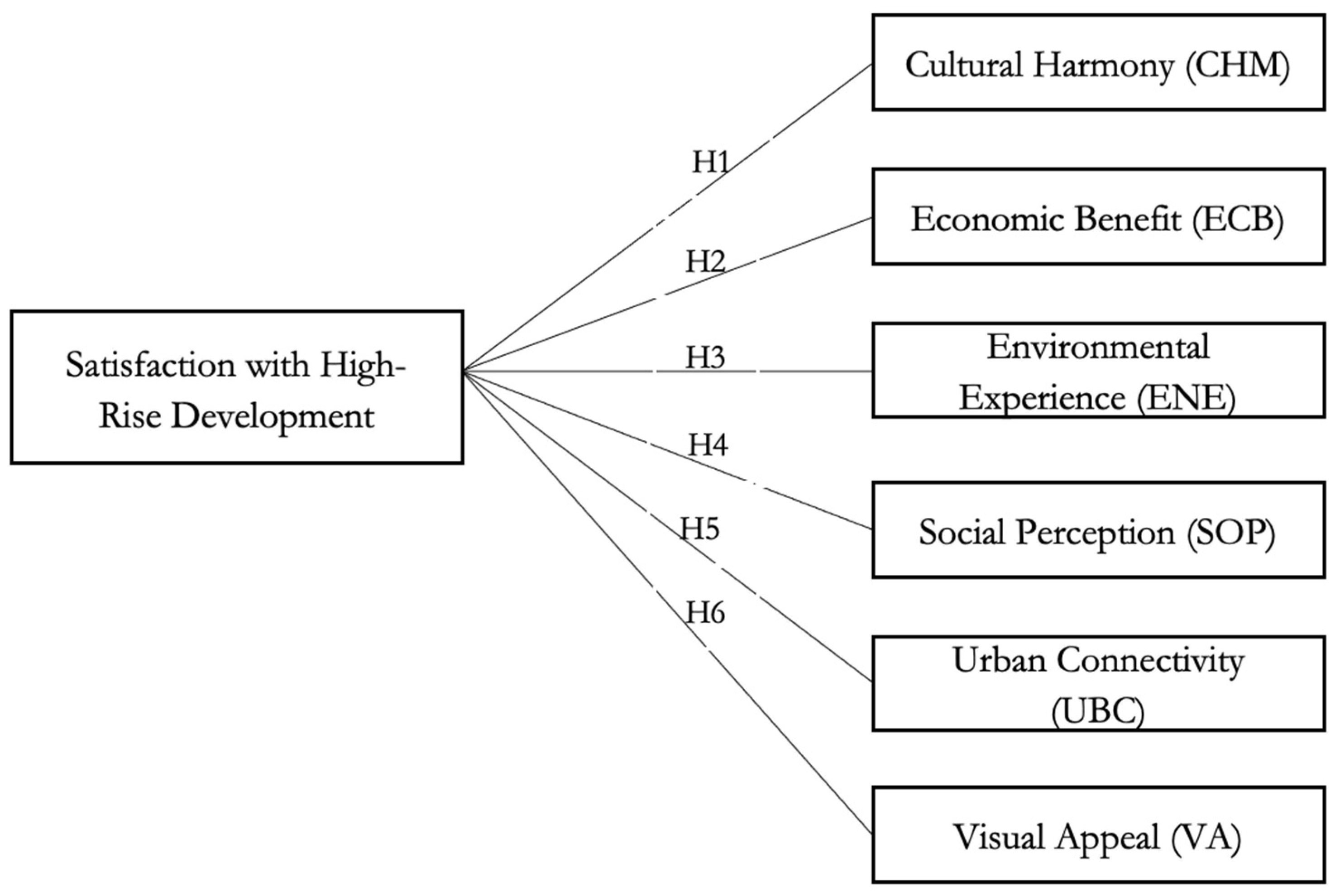

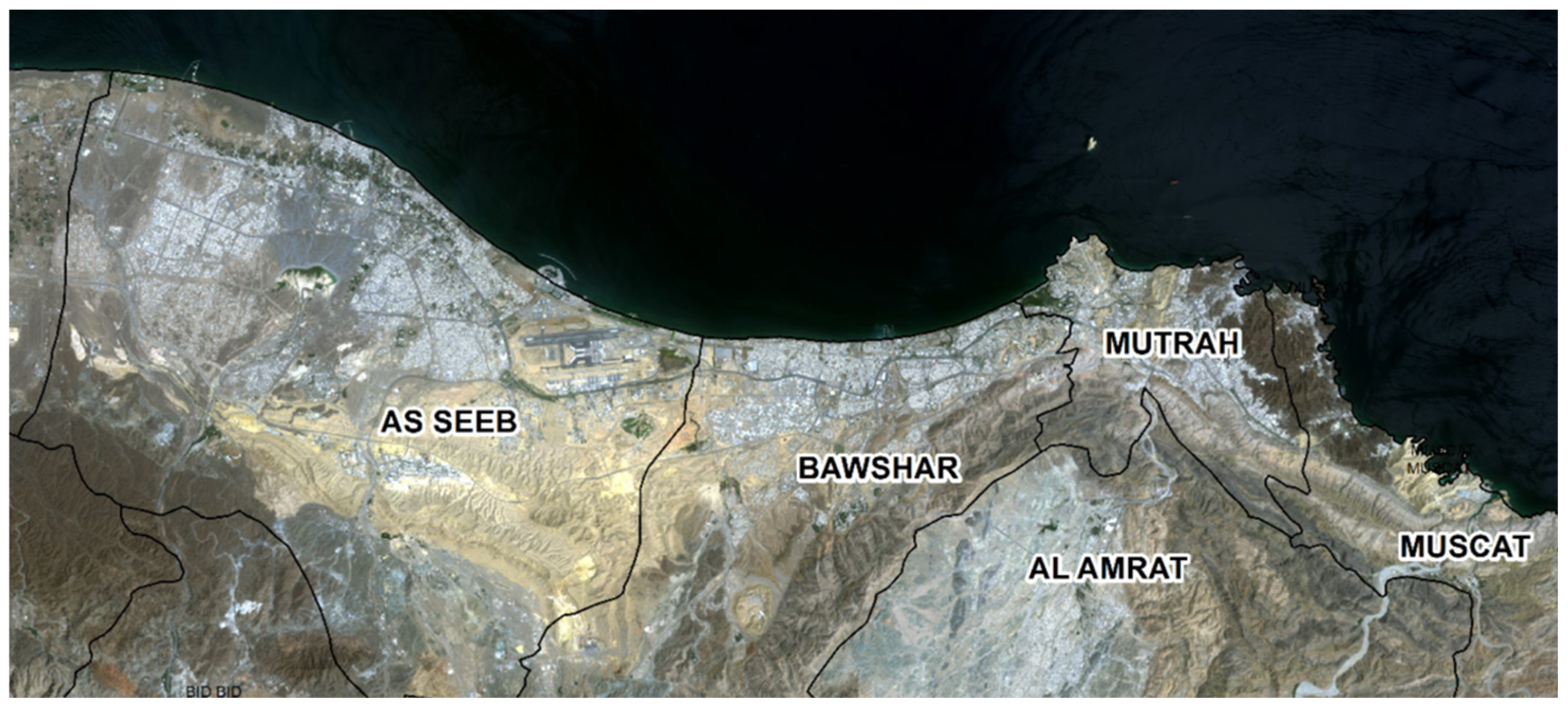
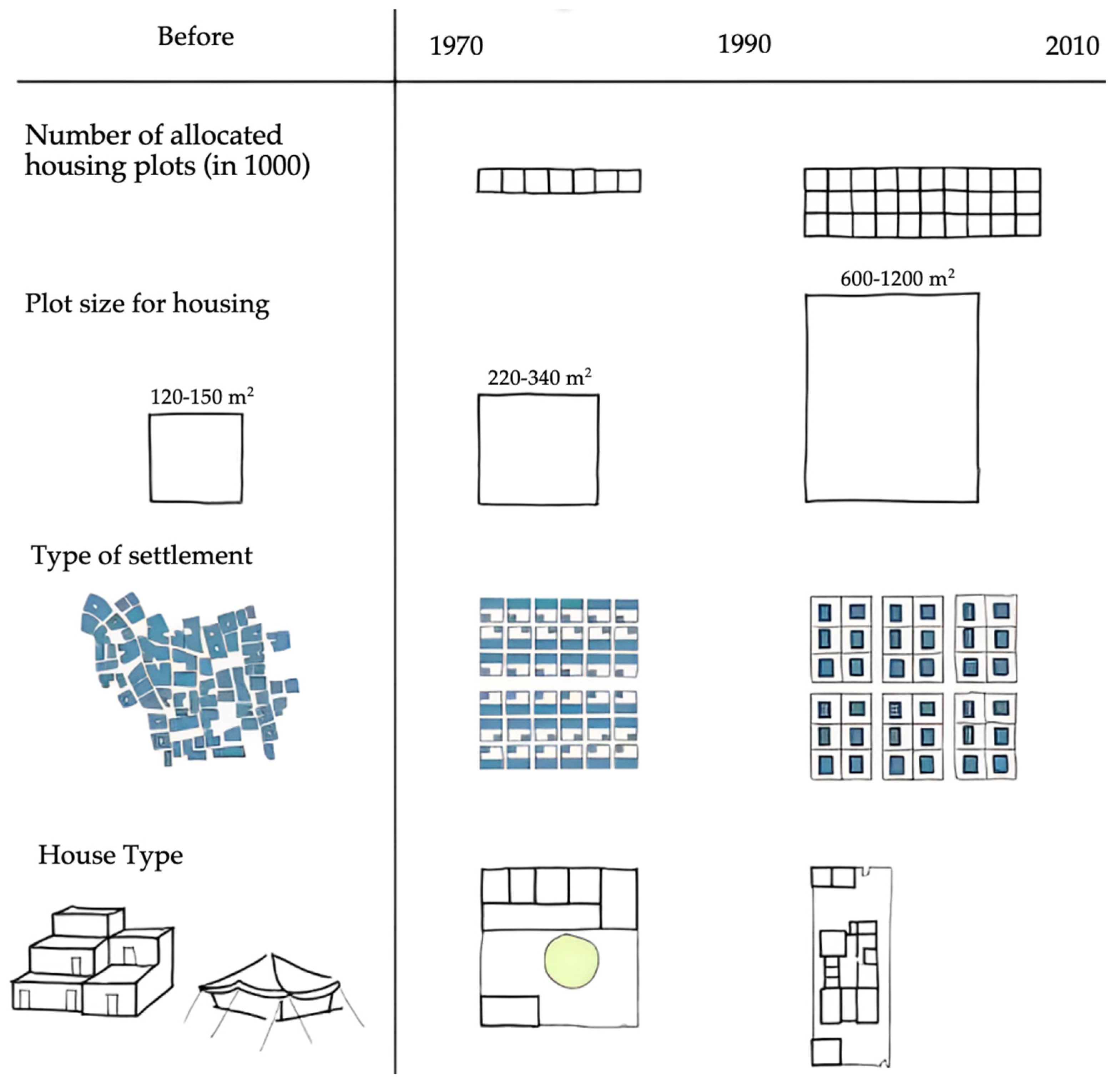
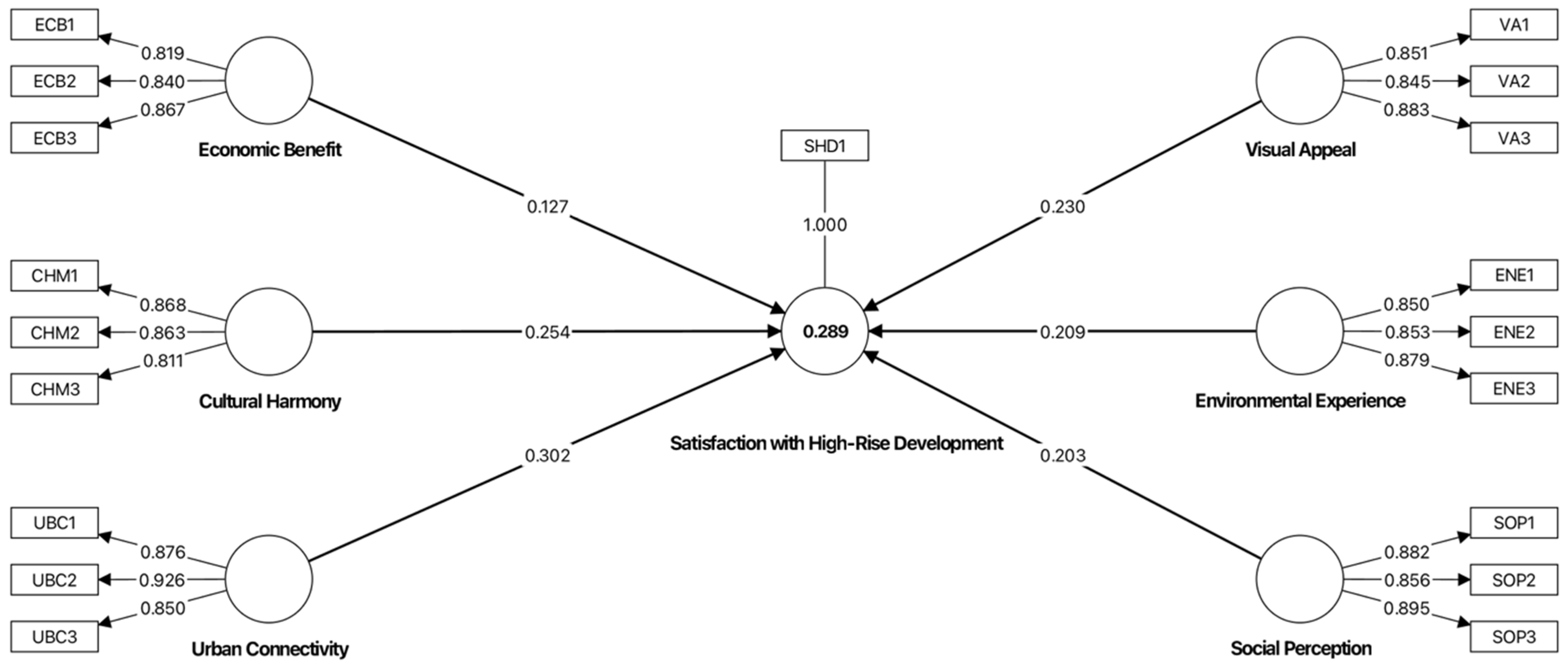


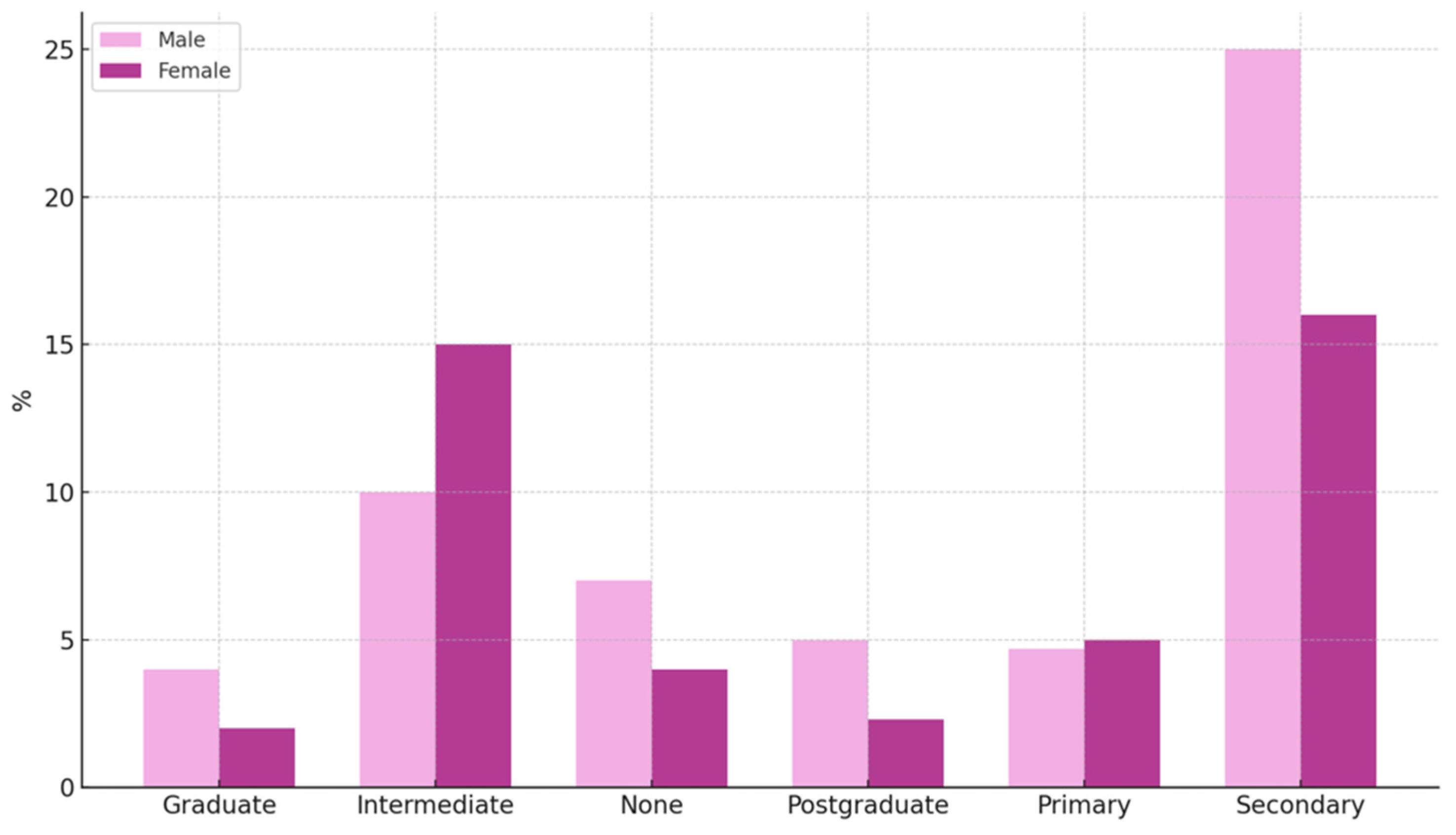
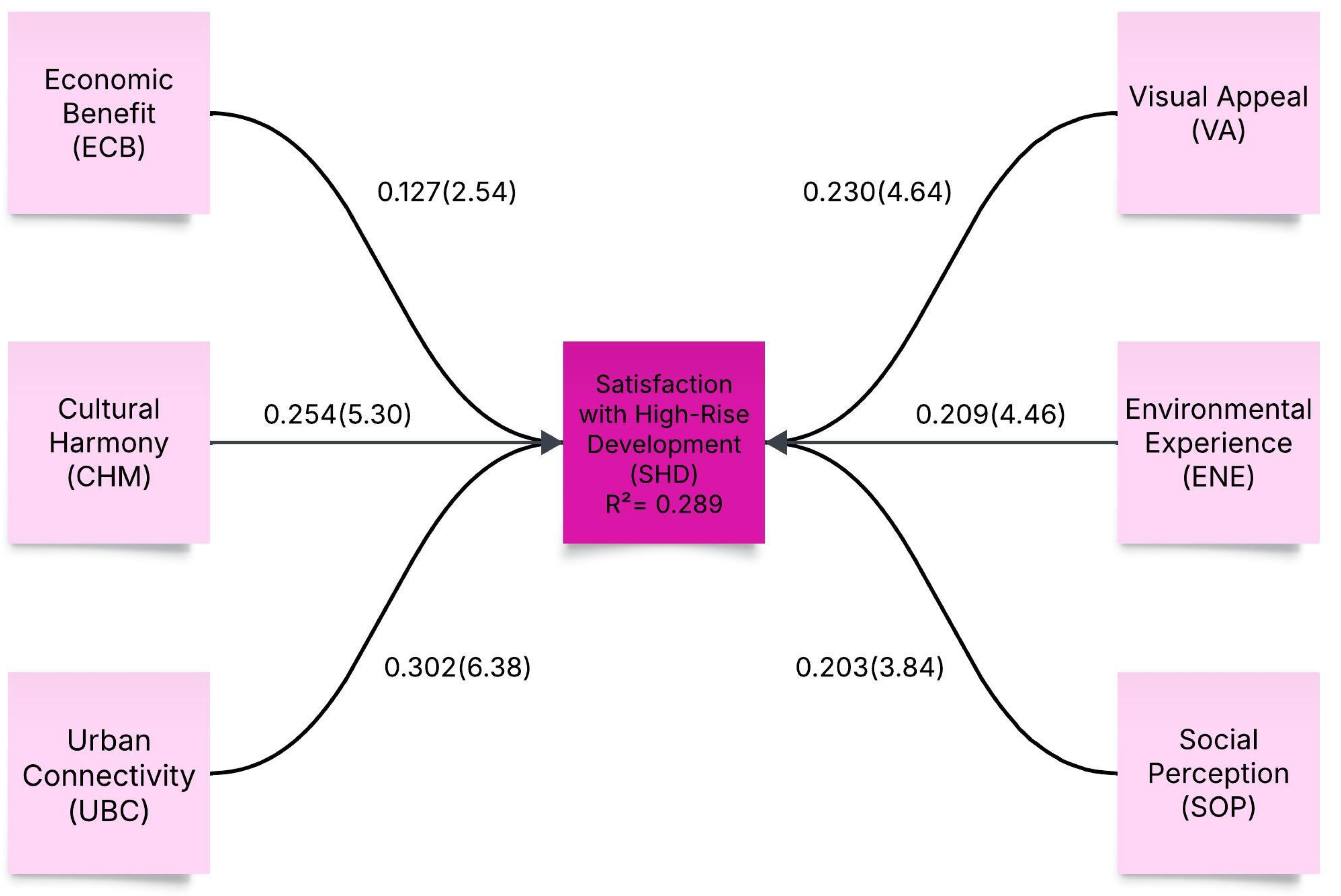
| Factors/Dimensions | Country | Reference |
|---|---|---|
| Economics of vertical urbanism | UK/AUS | [60] |
| Economic equity | Australia | [61] |
| Environmental heat island effects | Malaysia | [62] |
| Environmental design efficiency | Turkey | [63] |
| Micro-environmental impacts | Pakistan | [64] |
| Cultural identity | Egypt | [65] |
| Cultural acceptance | Malaysia | [66] |
| Social perception | Australia | [67] |
| Social cohesion | USA | [68] |
| Urban connectivity/TOD | Global review | [69] |
| Street-level integration | Denmark/Global | [70] |
| Mobility impacts | Australia | [71] |
| Visual aesthetics | USA | [72] |
| Visual quality governance | UK | [73] |
| Skyline management | Qatar | [74] |
| Group | Item | Description of Item |
|---|---|---|
| Demographic Information | Age | What is your age group? |
| Gender | What is your gender? | |
| Education | What is your highest level of education? | |
| Occupation | What is your current occupation? | |
| Income | What is your monthly household income in OMR? | |
| Stay Duration | How long have you lived in Muscat? | |
| Cultural Harmony (CHM) | CHM1 | I believe that high-rise buildings in Muscat blend traditional architectural elements (arches & motifs) with modern design. |
| CHM2 | I feel that high-rise developments help preserve clear views of Muscat’s historic landmarks (forts and surrounding mountains). | |
| CHM3 | I think the public spaces inside high-rise buildings reflect Omani cultural practices, for example by providing communal majlis areas. | |
| Economic Benefit (ECB) | ECB1 | I believe high-rise buildings make a significant contribution to Muscat’s economic and tourism growth. |
| ECB2 | I think high-rise projects create job opportunities and boost local businesses in Muscat. | |
| ECB3 | I find the locations of Muscat’s high-rise buildings to be easily accessible. | |
| Environmental Experience (ENE) | ENE1 | I perceive that energy consumption, such as air-conditioning and water use, is high in Muscat’s high-rise buildings. |
| ENE2 | I believe that constructing high-rise buildings in Muscat should prioritise eco-friendly materials. | |
| ENE3 | I feel that high-rise buildings negatively affect Muscat’s local climate by disrupting wind patterns and increasing temperatures. | |
| Social Perception (SOP) | SOP1 | I think high-rise developments undermine traditional values and customary living norms in Muscat. |
| SOP2 | I believe high-rise developments should integrate more traditional cultural elements. | |
| SOP3 | I feel that Muscat’s high-rise buildings offer sufficient communal spaces for social interaction. | |
| Urban Connectivity (UBC) | UBC1 | I find that high-rise buildings in Muscat are well connected to public transportation, such as buses and any future metro services. |
| UBC2 | I think pedestrian-friendly features like shaded walkways and parks are available around most high-rise developments in Muscat. | |
| UBC3 | I believe high-rise buildings give me convenient access to essential services such as schools, hospitals, and markets. | |
| Visual Appeal (VA) | VA1 | I feel that the presence of high-rise buildings enhances Muscat’s overall visual appeal. |
| VA2 | I find the architectural design, colours, and materials used in Muscat’s high-rise buildings aesthetically pleasing. | |
| VA3 | I believe future high-rise projects in Muscat should adopt more modern and innovative designs. |
| KMO and Bartlett’s Test | ||
|---|---|---|
| Kaiser–Meyer–Olkin Measure of Sampling Adequacy | 0.690 | |
| Bartlett’s Test of Sphericity | Approx. Chi-Square | 2161.534 |
| df | 153 | |
| Sig. | <0.001 | |
| Constructs | Items | Loadings | AVE | CR |
|---|---|---|---|---|
| Cultural Harmony | CHM1 | 0.868 | 0.718 | 0.884 |
| CHM2 | 0.863 | |||
| CHM3 | 0.811 | |||
| Economic Benefit | ECB1 | 0.819 | 0.710 | 0.880 |
| ECB2 | 0.840 | |||
| ECB3 | 0.867 | |||
| Environmental Experience | ENE1 | 0.850 | 0.741 | 0.896 |
| ENE2 | 0.853 | |||
| ENE3 | 0.879 | |||
| Social Perception | SOP1 | 0.882 | 0.770 | 0.909 |
| SOP2 | 0.856 | |||
| SOP3 | 0.895 | |||
| Urban Connectivity | UBC1 | 0.876 | 0.783 | 0.915 |
| UBC2 | 0.926 | |||
| UBC3 | 0.850 | |||
| Visual Appeal | VA1 | 0.851 | 0.739 | 0.895 |
| VA2 | 0.845 | |||
| VA3 | 0.883 |
| 1 | 2 | 3 | 4 | 5 | 6 | |
|---|---|---|---|---|---|---|
| CHM | 0.847 | |||||
| ECB | 0.072 | 0.843 | ||||
| ENE | 0.075 | 0.025 | 0.861 | |||
| SOP | 0.002 | 0.070 | −0.078 | 0.877 | ||
| UBC | −0.068 | −0.036 | −0.066 | 0.006 | 0.885 | |
| VA | 0.008 | 0.004 | 0.019 | −0.015 | −0.091 | 0.860 |
| 1 | 2 | 3 | 4 | 5 | 6 | |
|---|---|---|---|---|---|---|
| CHM | ||||||
| ECB | 0.089 | |||||
| ENE | 0.110 | 0.081 | ||||
| SOP | 0.282 | 0.172 | 0.220 | |||
| UBC | 0.078 | 0.083 | 0.093 | 0.202 | ||
| VA | 0.090 | 0.055 | 0.081 | 0.255 | 0.062 |
| Path Coefficient (β) | Sample Mean (M) | Standard Deviation (STDEV) | t-Value | f-Square | Decision | |
|---|---|---|---|---|---|---|
| H1: CHM -> SHD | 0.254 | 0.256 | 0.048 | 5.304 ** | 0.089 | Accepted |
| H2: ECB -> SHD | 0.127 | 0.132 | 0.050 | 2.542 * | 0.022 | Accepted |
| H3: ENE -> SHD | 0.209 | 0.213 | 0.047 | 4.457 ** | 0.061 | Accepted |
| H4: SOP -> SHD | 0.203 | 0.206 | 0.053 | 3.842 ** | 0.057 | Accepted |
| H5: UBC-> SHD | 0.302 | 0.303 | 0.047 | 6.377 ** | 0.126 | Accepted |
| H6: VA -> SHD | 0.230 | 0.232 | 0.050 | 4.640 ** | 0.074 | Accepted |
| Rank | Construct (Latent Code) | Empirical Signal 1 | Core Insight | Key Survey Items | Practical Takeaway for Planners |
|---|---|---|---|---|---|
| 1 | Urban Connectivity (UBC) | Largest, most robust driver of satisfaction | Residents rate walkability, street permeability and transit proximity above all else when judging high-rise areas. | UBC1—walkable block length UBC2—continuous shaded sidewalks UBC3—distance to bus/BRT stop | Break super-blocks, add shaded footpaths, integrate feeder bus loops before approving new towers. |
| 2 | Cultural Harmony (CHM) | Second strongest influence | Façades, materials and layouts that echo Omani motifs materially boost acceptance. | CHM1—respect for vernacular motifs CHM2—compatibility with traditional streetscapes CHM3—heritage preservation | Embed vernacular palettes, step heights near heritage zones, require courtyard elements. |
| 3 | Visual Appeal (VA) | Third strongest influence | Design quality and skyline contribution remain critical; aesthetics have “regulatory teeth.” | VA1—façade articulation VA2—skyline contribution VA3—material quality | Maintain rigorous design review; enforce massing and color palette guidelines from the Urban Design Manual. |
| 4 | Environmental Experience (ENE) | Mid-tier but significant | Heat mitigation and energy efficiency are now baseline expectations, not add-ons. | ENE1—thermal comfort ENE2—energy-efficiency performance ENE3—micro-climate quality | Make high-albedo skins, deep shading and vegetated podiums standard; reward passive-cooling design. |
| 5 | Social Perception (SOP) | Mid-tier, statistically robust | Kinship culture demands vertical projects replicate everyday social interaction. | SOP1—sense of neighborliness SOP2—trust in fellow residents SOP3—quality of shared spaces | Provide semi-private lobbies, communal terraces and mixed-tenure floor clusters to sustain social capital. |
| 6 | Economic Benefit (ECB) | Smallest yet still significant | Residents look for tangible job creation and local economy multipliers, but only after livability factors. | ECB1—local job generation ECB2—business and retail turnover ECB3—property value uplift | Tie approvals to local employment targets and SME tenancy incentives; publicize multiplier studies. |
Disclaimer/Publisher’s Note: The statements, opinions and data contained in all publications are solely those of the individual author(s) and contributor(s) and not of MDPI and/or the editor(s). MDPI and/or the editor(s) disclaim responsibility for any injury to people or property resulting from any ideas, methods, instructions or products referred to in the content. |
© 2025 by the authors. Licensee MDPI, Basel, Switzerland. This article is an open access article distributed under the terms and conditions of the Creative Commons Attribution (CC BY) license (https://creativecommons.org/licenses/by/4.0/).
Share and Cite
Al Sulaimani, G.; Arif, M.M.; Adeel, A.; Basheer, M.A.; Sheikh, N.B. Rethinking Vertical Cities: The Influence of Public Perception on Design, Form, and Socio-Cultural Integration. Societies 2025, 15, 250. https://doi.org/10.3390/soc15090250
Al Sulaimani G, Arif MM, Adeel A, Basheer MA, Sheikh NB. Rethinking Vertical Cities: The Influence of Public Perception on Design, Form, and Socio-Cultural Integration. Societies. 2025; 15(9):250. https://doi.org/10.3390/soc15090250
Chicago/Turabian StyleAl Sulaimani, Ghaida, Muhammad Mashhood Arif, Ahmad Adeel, Muhammad Aamir Basheer, and Nida Batool Sheikh. 2025. "Rethinking Vertical Cities: The Influence of Public Perception on Design, Form, and Socio-Cultural Integration" Societies 15, no. 9: 250. https://doi.org/10.3390/soc15090250
APA StyleAl Sulaimani, G., Arif, M. M., Adeel, A., Basheer, M. A., & Sheikh, N. B. (2025). Rethinking Vertical Cities: The Influence of Public Perception on Design, Form, and Socio-Cultural Integration. Societies, 15(9), 250. https://doi.org/10.3390/soc15090250









